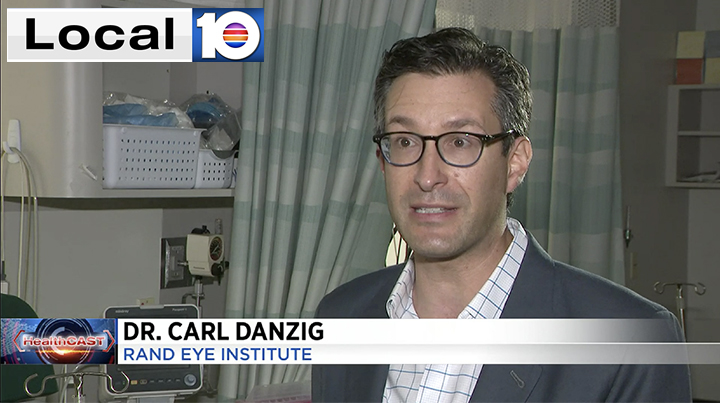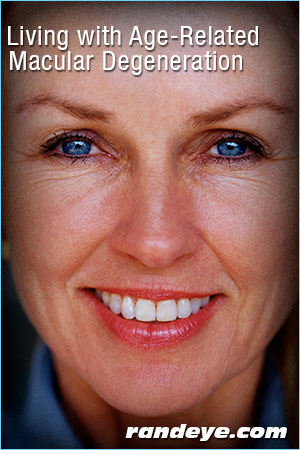Clinical Trials Study investigates gene therapy for vision condition
Rand Eye Institute Director of Vitreo-Retinal Services Dr. Carl Danzig is the first in South Florida to administer an investigational gene therapy for people with dry age-related macular degeneration, commonly known as AMD.
The clinical trial, called Horizon, involves a single, one-time injection under the retina at the back of the eye to deliver this gene therapy.
“This is different than wet macular degeneration, which people know about, that takes place in the office. This is in the operating room, where we enter the eyeball and we go under the retina with a very tiny needle and we inject some gene therapy, and what this does, it provides instructions for your own cells to produce a natural regulatory protein that you already have and basically upregulate that — you make that more and therefore, hopefully, fight the progression of this disease,” Danzig said.
Click the link below to watch the full interview as seen on Local 10 HealthCAST with Kristi Krueger.
https://www.local10.com/health/2022/02/17/study-investigates-gene-therapy-for-vision-condition/
Stargardt’s Macular Degeneration
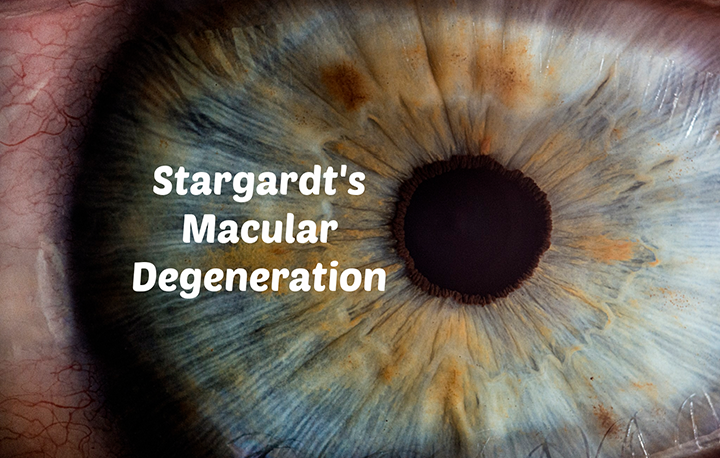
Stargardt’s disease is an inherited disorder of the retina. This disease starts to develop visual changes in patients in their childhood or teenage years. The changes are gradual but constant until their vision is decreased approximately to 20/200 or worse uncorrected. This condition is also called Stargardt’s macular dystrophy, juvenile macular degeneration, or fundus flavimaculatus. This disease damages or degenerates the macula, which is in the retina. The macula is the area in the eye that delivers sharp straight-ahead vision.
Patients with Stargardt’s experiences a slow and constant central vision loss, hence, becoming sensitive to bright lights. The retina contains light-sensing cells called photoreceptors. These are called rods and cones. Both rods and cones photoreceptors gradually die due to this disease.
As we mentioned earlier, this disease is inherited in most instances due to a mutation in a gene called ABCA4. The ABCA4 gene created a protein that clears Vitamin A byproducts inside the photoreceptors. Due to the cells not being cleansed, the cells become full of fatty substances and consequently the cell dies. This degeneration starts to happen around the macula which is the reason why patients start losing their central vision.
To diagnose Stragardt’s disease, an eye physician needs to do a thorough and complete eye exam.
The following tests are recommended:
- Slit eye exam. An eye physician will see the fatty deposit in the macular under the microscope if Stargardt’s is present
- Visual field testing to determine the areas and progression of the disease
- Color testing determine if the patient is becoming color blind
- A fundus photo which is a detailed picture of the retina
- An electroretinography (ERG) measures the response of cones and rods to light
- Optical Coherence Tomography (OCT) which is a light wave scanning device of the retina
Treatment Options
Unfortunately, there is no treatment for Stargardt’s. Patients are encouraged to wear dark sunglasses, not to smoke, and not to take Vitamin A supplements. Low vision aids are quite sophisticated right now and they can lend a lot of help by magnifying images or providing voice commands. Many Stargardts patients become visually disabled in their 20s which can take a significant emotional toll on the individual and their loved ones. Good medical eye care, counseling, and a supportive circle of friends and family are necessary to best confront this disease. There are multiple studies and research worldwide in the works addressing the degeneration of the macula. We look forward, with anticipation, to a new treatment in the medical field to aid all our patient’s with Stargardt’s and Macular Degeneration.
Tips for Self-Checking Your Vision for AMD
February may be the shortest month of the year, but it turns out to be the month we recognize the biggest cause of vision loss: Macular Degeneration, or AMD. More than 10-million Americans are affected by AMD, that’s more than people affected with cataracts and glaucoma combined.
The truth is that you or someone you love can be at risk for macular degeneration. Let’s outline some of the ways to see if you have the beginning stages of AMD, the leading cause of blindness in Americans 60 and older.
The first indication could be what you see or don’t see:
- Early signs of AMD include blurred vision and trouble distinguishing color and fine details.
- Difficulty seeing when going from bright light to low light and the need for increasingly brighter light to see up close.
- Colors appear less vivid and the vision is often hazy, or you see a blank or blurry spot in your central vision.
As the condition worsens, you could even lose your center of vision. Source AAO.
The Best Defense Against AMD is a Good Offense
The American Macular Degeneration Foundation recommends that you test your vision using The Amsler Grid (figure A below). It’s a lined graph that helps you determine if you have AMD.
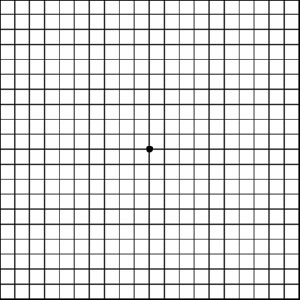
(Figure A)
Figure A above is the normal Amsler Grid. Wear your reading glasses and look at the grid holding it 12 to 15 inches away from your face in good light following these instructions. You can print the grid here:
- Cover one eye.
- Look directly at the center dot with the uncovered eye and keep your eye focused on it.
- While looking directly at the center dot, note whether all lines of the grid are straight or if any areas are distorted, blurry or dark.
- Repeat this procedure with the other eye.
- If any area of the grid looks wavy, blurred or dark, contact your ophthalmologist.
- If you detect any changes when looking at the grid, you should notify your ophthalmologist immediately.
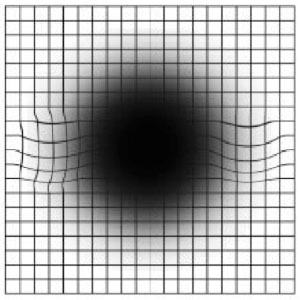
(Figure B)
Figure B above is the way the chart could look to you if you have age-related macular degeneration, with wavy lines and a black spot seen at center. Use the Amsler Grid to help you spot AMD early, so you can continue to enjoy clear vision.
Source: AAO
Macular Degeneration Wet vs Dry (AMD)
Imagine looking through a pair of dirty binoculars, a spyglass or a window that’s fogged up in the center. That’s what vision can look like to someone with macular degeneration.
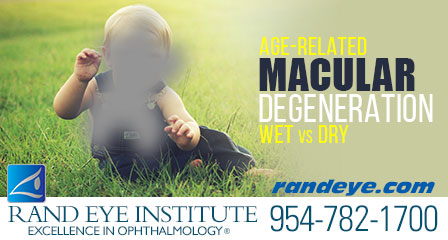
Age-related macular degeneration or AMD, is the leading cause of blindness in people over the age of 60, it gradually diminishes central vision. Because detailed vision is processed by the macula, the central part of the retina, when the macula becomes damaged, daily activities like driving, reading and identifying faces become more difficult and eventually impossible.
There are two forms of macular degeneration: Wet and Dry
The dry form
The dry form is diagnosed in 85 to 90% of cases and it can occur in one eye or in both. The dry form is called “non-neovascular”, because it does not involve the leakage of blood or serum, but the deterioration of the retina, associated with the formation of small yellow deposits, known as drusen, under the macula.
The wet form
Though it occurs in only 10-15% of the cases, it results in 90% of the blindness associated with AMD. Wet AMD comes about when abnormal blood vessels begin growing behind the macula. These fragile vessels will leak fluid into layers of the retina (hence the name “wet” AMD), causing the macula to bulge or lift up from its normally flat position, distorting or destroying central vision. Vision loss from “wet” AMD may be rapid and severe.
While currently there is no cure for dry macular degeneration, those with wet macular degeneration may benefit from intraocular injections.
“With treatment, many patients have visual improvement and most patients are able to maintain their current vision without further vision loss. Without treatment, the condition usually worsens,” said Carl Danzig, MD, Director of Vitreo-Retinal Services at Rand Eye Institute.
AMD is one more reason why it’s so important to schedule a comprehensive dilated eye exam every 1-2 years.
Next time, we’ll suggest ways to test for AMD and offer some strategies for your best defense and prevention against macular degeneration, during Age-related Macular Degeneration Awareness Month.
Age-Related Macular Degeneration (AMD)
It’s February, The Month of Love, but let’s not wait until Cupid’s arrow falls to give our expressive eyes the respect and attention they so lovingly deserve.
February is the month that we pay special attention to Age-related Macular Degeneration (AMD), the leading cause of blindness among older Americans. The numbers are rising so high, so fast, that the American Macular Degeneration Foundation estimates that by 2030, 6.3 million Americans will be affected by AMD, the condition that limits a person’s ability to read and recognize faces.
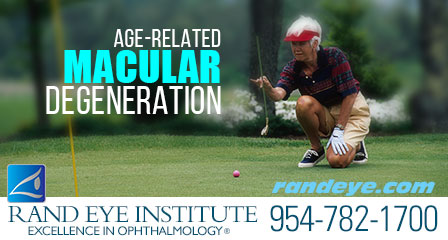
As of today, there is no sure-fire cure for AMD, but there are some simple steps you can take to prevent it from happening to you:
Since AMD has no early warning signs, getting a regular comprehensive eye exam from an ophthalmologist is critical to diagnosing and treating AMD in its early stages. It is recommended that people over 65 have an exam every one to two years, even if they have no symptoms or eye problems.
Your family history plays a role in your future contact with AMD. If you have a close relative with AMD, you have a 50% chance of developing the condition. Speak with your family and research your family history for AMD. The earlier it is caught, the better the chance of saving your vision.
Diet plays a significant role in reducing AMD. Studies published in the American Journal of Epidemiology, Ophthalmology and Archives of Ophthalmology found higher levels of lutein and zeaxanthin in the diet are associated with a lower incidence of AMD. These include diets rich in omega-3 fatty acids such as fish. Maintaining proper weight and reducing your intake of saturated fats and cholesterol also helps prevent AMD. See these foods and recipes helpful in warding off AMD.
Quit smoking. This is always recommended whether you are at risk for AMD or not. Studies by the American Academy of Ophthalmology have shown that smokers are twice as likely to develop macular degeneration compared with non-smokers.
There are two types of AMD. In our next blog, we’ll define them both for you.
Life With Low Vision
Low vision means that even with regular glasses, contact lenses, medicine or surgery, people may find completing daily tasks they were once comfortable doing, become a great struggle.
Here are some things you can do to help you live more comfortably with Age-Related Macular Degeneration:
Lighting
Good lighting can make a big difference in aiding with vision when it comes to reading a book or knitting.
Having too much or too little light can be dangerous for a person’ with low vision, so it is extremely important to test out different lights and their levels.
Eating The Right Stuff
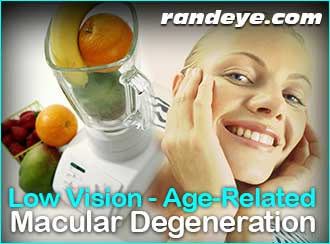
Eating the right kind of food cannot reverse macular degeneration, but it can help control it or prevent it from developing.
Eat a lot of fruits and vegetables: Antioxidants fight against oxidation, which is a part of the process of AMD. Dark, leafy vegetables like kale, spinach, mustard greens and collard greens are great because they contain lutein, which is a critical antioxidant. Fruits and vegetables are also stock full of antioxidants. Red grapes, peppers, corn, oranges, cantaloupe and mango are great choices.
Eat Fish: People who eat fish 2-3 times a week have a much lower risk of developing AMD, because of the Omega-3.
Control your Fat Intake: Research has shown that the amount of saturated fats consumed in diets is a big problem for people with low vision.
Computers
Computers can help people with low vision with their work, shopping, banking, etc.
Changing the settings on your computer can help with brightness and dimness, font size and much more.
Also, choosing the right pair of glasses is important in working with computers. Distance glasses are designed to focus on objects at 20 feet. Reading glasses are designed to focus at 12 to 16 inches when you look down. Choose glasses that focus specifically on your computer screen. They should also have a filter that will reduce glare.
Driving
Driving with low vision is extremely dangerous and should be avoided at all cost.
If you are having symptoms of age-related Macular Degeneration, schedule a comprehensive eye examination today.
Common Types of Age-Related Macular Degeneration
Dry and Wet Macular Degeneration
Both types destroy the clear, see-straight central vision that is needed for reading, driving, identifying faces, watching television and other daily activities.
Peripheral vision may not be affected. It may also be possible to see side views, in some cases.
Dry AMD
About 90% of AMD cases are classified as dry Age-related Macular Degeneration(AMD).
Usually, AMD starts as the dry type, then can develop in one or both eyes. This process is slow and can advance over several years.
Many people do not even realize they have AMD, because early dry AMD usually has little to absolutely no symptoms.

Three Stages of Dry AMD:
- Early: In this stage, central vision is not affected. People in this stage may develop some small drusen (yellow deposits under the retina), but there is a low risk of it becoming advanced-dry AMD.
- Intermediate: In this stage, both the near and distance vision is affected. A person may have a blind spot or their central vision may be blurred. People with intermediate dry AMD are more likely to have many medium-sized drusen, or one or more large drusen.
- Advanced: In the advanced stage, cells in the macula lose their ability to function completely. A person’s sightline is completely blurred. Over time, vision will most likely worsen and tasks such as reading or recognizing faces becomes extremely difficult. Up to 43 percent of people in this stage of dry AMD will progress to wet AMD, the more aggressive form of the disease.
Wet AMD
Wet Age-Related Macular Degeneration is the most severe form of Age-Related Macular Denegation. Wet AMD can cause a sudden loss of vision within a short period of weeks or months.
In Wet AMD, abnormal blood vessels below the retina grow unexpectedly. These blood vessels break into the macula and cause blood and other fluids to leak.
Once wet AMD is presented in one eye, the chance of it developing in the second is greater.
Understanding Age-Related Macular Degeneration
The macula consists of millions of light-sensing cells which provide sharp, central vision.
The Macula is the most sensitive part of the retina and is located at the back of the eye. The retina turns light into electrical signals and then sends these electrical signals through the optic nerve and then it reaches the brain. Here they are translated into images that we see.
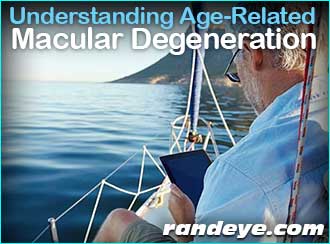
So What is Age- Related Macular Degeneration?
Age-related Macular Degeneration (AMD) is a common eye condition and one of the leading cause of vision loss among people age 50 and older.
AMD is caused by damage to the macula, and can result in blurred, dark and distorted vision.
In some people, AMD advances slowly so vision loss does not occur for a long time.
In other people, the disease can cause damage way faster and vision loss in one or both eyes, is likely to occur.
Am I at Risk for AMD?
Age plays a very big role in age-related Macular Degeneration.
The disease is more likely to occur after the age of 60.
Other risk factors include:
- Smoking- Research has proven that smoking can double the risk for this disease.
- Race- It is more common in Caucasians then in African Americans or Hispanic/Latinos.
- Family History- People with a family history are at much higher risk.
- Obesity- Severely overweight individuals have an increased risk of developing AMD.
If you or a loved one is experiencing signs of macular degeneration, it is recommended that you have a complete eye exam as soon as possible, to minimize loss of vision.
Living with Age-Related Macular Degeneration
How to Improve your Daily Life When Having (AMD) Age-Related Macular Degeneration
If you are losing your sight, there are some things you can do to improve your vision and live more comfortably.
Millions of people live with macular degeneration and they continue to complete their daily tasks as they always have.
Lighting-
Good lighting can make a big difference, especially if you are planning on performing a task that requires attentive sight, such as reading a book or knitting. Having good lighting also creates a safer environment and helps prevent accidents.
Having too much or too little light can be dangerous for a person with low vision. Testing out different kinds of lights and their levels can help you determine which you are most comfortable seeing with.
Computers-
Computers can be very valuable for people with low vision. It can help them perform their work, shop, bank and communicate with friends with more ease. Changing the settings on your computer can help with brightness and dimness, font size and much more.
Choosing the right pair of glasses is important in working well with computers. Distance glasses are designed to focus on objects at 20 feet. Reading glasses are designed to focus at 12 to 16 inches when you look down. Computer screens are generally positioned straight ahead at a distance of 20 inches from your eyes. Choose glasses that focus specifically on your computer screen. These glasses should also include a filter to reduce glare and reflections.
Driving-
Driving with low vision is extremely dangerous and should be avoided at all cost. If you do pass the Department of Motor Vehicles driving test, take precautions while operating a car.
Always wear your glasses.
Eating Right-
Although eating the right food cannot reverse maculate degeneration, it can help control and prevent it.
Eat a lot of fruits and vegetables: Antioxidants fight against oxidation, which is a part of the process of AMD. Consuming dark, leafy vegetables like kale, spinach, mustard greens and collard greens is great because it contains lutein, which is a critical antioxidant. Antioxidants are also found in fruits and vegetables with bright colors, such as red grapes, peppers, corn, oranges, cantaloupe and mango.
Eat Fish: People who eat fish 2-3 times a week have a much lower risk of developing AMD, because of the Omega-3. You can also get your Omega-3 intake by obtaining omega-3 supplements. Fish oil capsules are popularly chosen.
Limit Your Fat Intake: Research has shown that the real issue for AMD is the amount of saturated fats consumed in diets. The biggest source that people get comes from beef, pork, lamb, butter, whole milk, eggs, etc. Maintain your fat intake, by substituting them for something lower in fat.
Age-Related Macular Degeneration Types & Treatment
Types of Age-Related Macular Degeneration and How to Treat Them
There are two types of AMD: dry and wet. Both destroy the clear, see-straight central vision necessary for reading, driving, identifying faces, watching television and performing other daily activities. Peripheral vision may not be affected and it may be possible to see side views. Dry AMD About 90% of AMD cases are classified as dry Age-related Macular Degeneration. Usually, AMD starts as the dry type and can develop in one or both eyes. This process is slow and can advance over the course of several years, Many people do not even realize they have AMD, because early dry AMD is usually mild and free of symptoms.
Dry AMD has three stages:
- Early: In this stage, central vision is usually not affected. The eyes may have some small drusen, but there is a low risk of it progressing to advanced-dry AMD.
- Intermediate: In this stage, near and distance vision is affected, and a person may have a blind spot or blurring in the central vision. People with intermediate dry AMD are likely to have many medium-sized drusen, or one or more large drusen. After five years with intermediate dry AMD, the risk of it progressing toward the advanced stage is higher, but still low. For people with large drusen in both eyes, the risk of developing advanced AMD is greater.
- Advanced: At the advanced stage, the cells in the macula completely lose their ability to function. There is a definite blurred or blank spot in the centre of one’s sightline. Over time, vision will likely worsen and a person will have difficulty reading or recognizing faces. Up to 43 percent of people in this stage of dry AMD will progress to wet AMD, the more aggressive form of the disease.
Wet AMD
Wet Age-Related Macular Degeneration is the most severe form of AMD and can cause a sudden loss of vision within weeks or months. Recognizing and managing wet AMD early can asset in preventing further vision loss. Wet AMD involves the unexpected growth of abnormal blood vessels below the retina, which breaks into the macula causing blood and fluid to leak. Once wet AMD is presented in one eye, the chance of it developing in the second is greater.

